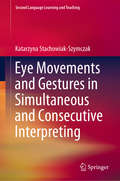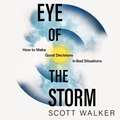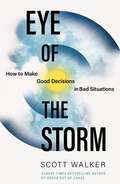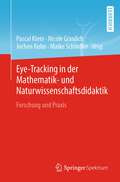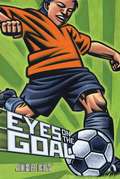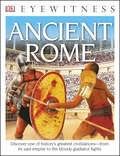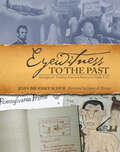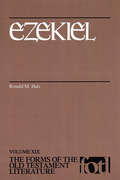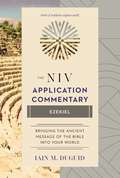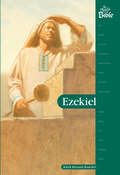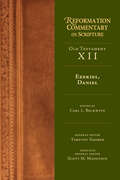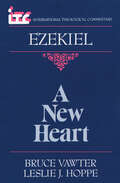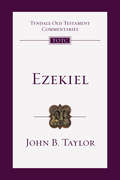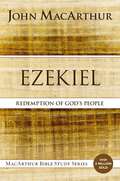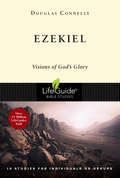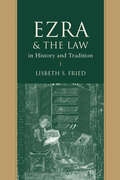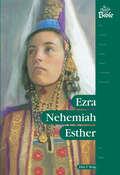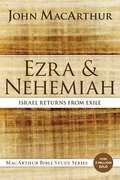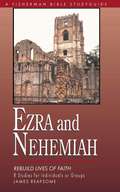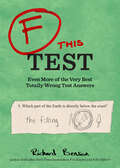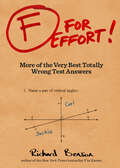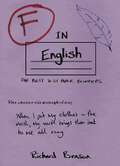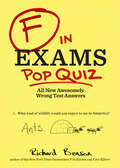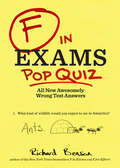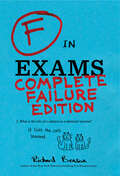- Table View
- List View
Eye Movements and Gestures in Simultaneous and Consecutive Interpreting (Second Language Learning and Teaching)
by Katarzyna Stachowiak-SzymczakThis book addresses eye movements and gestures as markers of language comprehension and production in interpreting as the "visible embodiment" of cognitive processing in simultaneous and consecutive interpreting. It discusses conference interpreting as a complex, multimodal activity where language processing is not restricted to auditory perception and oral production, highlighting the complexity of interpreting and exploring possible strategies that can be used by professional interpreters and students to make their work easier and more accurate.
Eye of the Storm: How to Make Good Decisions in Bad Situations
by Scott WalkerMaster your emotions, think clearly and make better decisions, even in the toughest of situations.Drawing from his extensive career as a kidnap-for-ransom negotiator, Scott Walker shares practical tools and insights to help you stay calm, act decisively and thrive under pressure.Whether you're facing challenges at home, managing workplace demands or dealing with daily stresses, this book will help you build resilience, resolve conflicts and strengthen relationships.If you enjoyed his Sunday Times bestseller, Order Out of Chaos (2023), you'll love this follow-up!
Eye of the Storm: How to Make Good Decisions in Bad Situations
by Scott WalkerMaster your emotions, think clearly and make better decisions, even in the toughest of situations.Drawing from his extensive career as a kidnap-for-ransom negotiator, Scott Walker shares practical tools and insights to help you stay calm, act decisively and thrive under pressure.Whether you're facing challenges at home, managing workplace demands or dealing with daily stresses, this book will help you build resilience, resolve conflicts and strengthen relationships.If you enjoyed his Sunday Times bestseller, Order Out of Chaos (2023), you'll love this follow-up!
Eye-Tracking in der Mathematik- und Naturwissenschaftsdidaktik: Forschung und Praxis
by Pascal Klein Jochen Kuhn Maike Schindler Nicole GraulichDieses Buch beschäftigt sich mit aktuellen Studien und Anwendungsmöglichkeiten von Eye-Tracking in der Mathematik- oder Naturwissenschaftsdidaktik: Was betrachten Lernende, wenn sie einen naturwissenschaftlichen Text lesen, mathematische Muster erkunden oder mit einem Diagramm arbeiten? Wie fokussieren und verteilen sie ihre Aufmerksamkeit beim Lösen mathematischer und naturwissenschaftlicher Aufgaben? Eye-Tracking liefert Antworten auf diese und weitere Fragen und kann somit dazu beitragen, Lernprozesse besser zu verstehen, Lernmaterialien und Lehrprozesse zu optimieren oder Unterschiede zwischen verschiedenen Expertisegruppen aufzudecken. Dieses Buch stellt aktuelle Studien aus der Mathematik- und Naturwissenschaftsdidaktik (Biologie, Chemie, Physik, Informatik) zusammen, die Eye-Tracking als zentrale Forschungsmethode zur Beantwortung von Fragestellungen entlang der Bildungskette (Primar- und Sekundarstufen sowie Universität) nutzen. Dabei wird deutlich, wie Eye-Tracking bereits etablierte Forschungsmethoden der empirisch forschenden Fachdidaktik, wie das Laute Denken, den Einsatz von Fragebögen oder Experteninterviews, ergänzt.Das Buch zeigt die vielfältigen Anwendungsmöglichkeiten von Eye-Tracking in der Mathematik- und Naturwissenschaftsdidaktik und enthält zahlreiche Best-Practice-Beispiele zum Design und zur Auswertung wissenschaftlicher Studien zum Thema. Das Buch richtet sich damit sowohl an Wissenschaftlerinnen und Wissenschaftler mit unterschiedlicher Erfahrung im Bereich Eye-Tracking als auch an (zukünftige) Lehrkräfte und Dozierende, da aus den empirischen Befunden Handlungsempfehlungen für den Unterricht bzw. die Lehre gegeben werden.
Eyes on the Goal
by John CoyJust before they're due to start middle school, Jackson, Gig, Isaac, and Diego, four sports-loving friends, all attend the same week long soccer camp. Diego is an experienced soccer player, and Gig has a natural ability for the sport he never realized. But Jackson and Isaac are split into another group of players--a group with younger, smaller kids. For the first time, both boys aren't the stars of their team. In fact, they can't seem to get a handle on soccer. At the same time, Jackson is having a hard time getting a handle on his mom's deepening relationship with her boyfriend, and her suggestion that they move in with him. And Gig is worried about his father's deployment to Afghanistan. Here is a story about how life, like sports, can be unpredictable, frustrating, and exhilarating.
Eyewitness Workbooks: Discover One Of History's Greatest Civilizations From Its Vast Empire To The Blo To The Bloody Gladiator Fights (DK Eyewitness)
by Simon James DK PublishingFrom Roman emperors and gods and goddesses to soldiers and gladiators, step into the exciting world of ancient Rome.Who were Rome's most famous emperors? What was everyday life like for a soldier in the Roman army? How did the citizens of ancient Rome live? Did gladiators really fight to the death in the mighty Colosseum? Find out the answers to all these questions, and many more, in Eyewitness: Ancient Rome.Photographs of real artifacts and detailed illustrations will help you to learn all about the time of ancient Rome, from a small city-state ruled by kings to one of the most powerful empires in history. Find out what a typical Roman house was like and what food Romans ate. Learn about how people spent their free time, whether paying a visit to the theatre, using the public bath, or watching gladiators fight a gruesome battle to the death in the world-famous Colosseum.Packed with fascinating facts, this illustrated guide is perfect for school projects or as an introduction for anyone who wants to know more about the history of ancient Rome.
Eyewitness to the Past: Strategies for Teaching American History in Grades 5-12
by Joan SchurThroughout history, people have often expressed controversial and conflicting interpretations of current events. In this unique resource, Joan Brodsky Schur reveals how compelling and engaging the study of history becomes when students use documents to imagine living through events in American history. Eyewitness to the Past examines six types of primary sources: diaries, travelogues, letters, news articles, speeches, and scrapbooks. Teachers will find interactive strategies to help students analyze the unique properties of each, and apply to them their own written work and oral argument. Students learn to express opposing viewpoints in documents, classroom interactions, and simulations such as staging congressional hearings, elections, or protests. They build crucial analytical thinking and presentation skills. Used together, the six strategies offer a varied and cohesive structure for studying the American past that reinforces material in the textbook, encourages creativity, activates different learning styles, and strengthens cognitive skills. Each chapter provides detailed instructions for implementing an eyewitness strategy set in a specific era of American history, and includes extensions for adapting the strategy to other time periods. In addition to the primary sources included in the book, examples of student work are presented throughout to aid teachers in evaluating the work of their own students. Rubrics and a list of resources are offered for each eyewitness strategy.
Ezekiel (The Forms of the Old Testament Literature (FOTL) #Volume Xix)
by Ronald M. HalsThis is a print on demand book and is therefore non- returnable. Hals analyzes in detail the structure and intention of the unusually long prophecies of Ezekiel. Because this prophet genuinely qualifies for the designation "theologian," Hals devotes much attention to examining Ezekiel's theological perspective and style. He argues that Ezekiel, despite his proclamations of judgment, is not a prophet of despair. Rather, Ezekiel affirms the stubborn grace of Israel's sovereign Lord — the God who follows his people into the death of exile and loss of nationhood and promises them life out of death via a new exodus, a new "peoplehood," and a new temple.
Ezekiel (The NIV Application Commentary)
by Iain M. DuguidThe NIV Application Commentary helps you communicate and apply biblical text effectively in today's context.To bring the ancient messages of the Bible into today's world, each passage is treated in three sections:Original Meaning. Concise exegesis to help readers understand the original meaning of the biblical text in its historical, literary, and cultural context.Bridging Contexts. A bridge between the world of the Bible and the world of today, built by discerning what is timeless in the timely pages of the Bible.Contemporary Significance. This section identifies comparable situations to those faced in the Bible and explores relevant application of the biblical messages. The author alerts the readers of problems they may encounter when seeking to apply the passage and helps them think through the issues involved.This unique, award-winning commentary is the ideal resource for today's preachers, teachers, and serious students of the Bible, giving them the tools, ideas, and insights they need to communicate God's Word with the same powerful impact it had when it was first written.
Ezekiel (The People's Bible)
by Kieth B KuschelWhat is the book of Ezekiel about? Who was Ezekiel in the Bible?The prophet Ezekiel was among the first of the Jewish people to be deported to Babylon in exile. Many Jews thought that God had abandoned his promises by allowing the captivity to happen. But through the words, actions, and visions of Ezekiel, God reminded his people of their sins and promised that a faithful remnant would return so that all of God’s promises about the Messiah would be fulfilled.Want to learn more? If you’re wondering what the book of Ezekiel is all about, this helpful resource is for you!Ezekiel is a reliable Bible commentary. It’s down to earth, clearly written, easy to read and understand, and filled with practical and modern applications to Scripture.It also includes the complete text of the book of Ezekiel from the NIV Bible. The Christ-centered commentaries following the Scripture sections contain explanations of the text, historical background, illustrations, and archaeological information. Ezekiel is a great resource for personal or group study!This book is a part of The People’s Bible series from Northwestern Publishing House.
Ezekiel, Daniel (Reformation Commentary on Scripture Series #12)
by Carl L. BeckwithThe Reformation era revolution in preaching and interpreting the Bible did not occur without keen attention to the Old Testament Scriptures. This is especially true with regard to the Hebrew prophets. Ezekiel and Daniel, replete with startling, unnerving imagery and visions, apocalyptic oracles of judgment and destruction, captivated the reformers as they sought to understand their time and themselves through the lens of Scripture. Equally, these prophetic books underscored the covenantal promises to God's people and the hope of restoration, which the Reformers understood to be the righteousness of Christ made available in faith. Reformation commentary on the prophets Ezekiel and Daniel are windows into the biblical, theological and pastoral minds of the reformers as they engage the details of the texts, make theological judgments and apply fresh reading of Scripture to their contemporary hearers. Familiar passages, such as Ezekiel's dazzling vision of the wheels, the building of the temple, or Daniel's four beasts, are given new layers and textures. This volume collects the comments of the monumental figures like Luther, Calvin and Melancthon, alongside many lesser known and read thinkers, such as Heinrich Bullinger, Hans Denck, Giovanni Diodati, Johann Gerhard, John Mayer, Matthew Mead, Johann Oecolampadius, Jakob Raupius, Johann Wigand and Andrew Willet. Several beloved English Puritans are included as well: Richard Baxter, John Bunyan, Thomas Manton and John Owen. The wealth of Reformation interpretation on these books of Scripture is brought together for the first time.
Ezekiel: A New Heart
by Bruce Vawter Leslie HopperThe prophet Ezekiel speaks passionately of God's fidelity even in the face of his people's infidelity, defending the destruction of Jerusalem as God's judgment while promising a new experience of the divine presence that will bring with it "a new heart" for God's people. Bruce Vawter and Leslie J. Hoppe illuminate the profound theological themes of Ezekiel, making him accessible to people today by stressing his proclamations of judgment and salvation as vital words for the people of God in every age.
Ezekiel: An Introduction and Commentary (Tyndale Old Testament Commentaries #Volume 22)
by John B. Taylor"For most Bible readers Ezekiel is almost a closed book," writes John Taylor. "Their knowledge of him extends little further than his mysterious vision of God's chariot-throne, with its wheels within wheels, and the vision of the valley of the dry bones." "Otherwise his book is as forbidding in its size as the prophet himself is in the complexity of his make-up," Taylor goes on. "In its structure, however, if not in its thought and language, the book of Ezekiel has a basic simplicity, and its orderly framework makes it easy to analyze." Taylor, in the introduction to this analysis of Ezekiel, sketches a portrait of the prophet and his times, carefully placing the book and its prophecies within their historical settings. He also provides an overview of the books themes and a clear outline of its contents. The original, unrevised text of this volume has been completely retypeset and printed in a larger, more attractive format with the new cover design for the series.
Ezekiel: Redemption for God's People (MacArthur Bible Studies)
by John F. MacArthurEzekiel was among the thousands of Jews taken captive when the Babylonians invaded Judah in 597 bc. It was there that God called him to be a prophet, and for the next twenty-two years, he related the visions, prophecies, and signs the Lord gave him to his fellow Jews living in exile. While these prophecies often contained warnings of severe judgments if the people did not repent, they also contained incredible messages of hope—including more details about the future millennial kingdom of Christ than all other Old Testament prophecies combined.In the twelve studies within, join John MacArthur to focus on Ezekiel's visions, prophecies, parables, signs, and symbols proclaiming and dramatizing the message of God to His exiled people. By working through this study, you will learn that in your life, just like the people of Israel, God holds each individual accountable for pursuing righteousness.The MacArthur Bible Studies provide intriguing examinations of the whole of Scripture. Each guide incorporates extensive commentary, detailed observations on overriding themes, and probing questions to help you study the Word of God with guidance from John MacArthur.
Ezekiel: Visions of God's Glory (LifeGuide Bible Studies)
by Douglas ConnellyEzekiel was a fascinating man who wrote a fascinating book filled with strange and powerful visions.®
Ezra & the Law in History and Tradition (Studies on Personalities of the Old Testament)
by Lisbeth S. FriedDiscover the real Ezra in this in-depth study of the Biblical figure that separates historical facts from cultural legends.The historical Ezra was sent to Jerusalem as an emissary of the Persian monarch. What was his task? According to the Bible, the Persian king sent Ezra to bring the Torah, the five books of the Laws of Moses, to the Jews. Modern scholars have claimed not only that Ezra brought the Torah to Jerusalem, but also that he actually wrote it, and in so doing Ezra created Judaism. Without Ezra, they say, Judaism would not exist.In Ezra and the Law in History and Tradition, Lisbeth S. Fried separates historical fact from biblical legend. Drawing on inscriptions from the Achaemenid Empire, she presents the historical Ezra in the context of authentic Persian administrative practices and concludes that Ezra, the Persian official, neither wrote nor edited the Torah, nor would he even have known it. The origin of Judaism, so often associated with Ezra by modern scholars, must be sought elsewhere.After discussing the historical Ezra, Fried examines ancient, medieval, and modern views of him, explaining how each originated, and why. She relates the stories told about Ezra by medieval Christians to explain why their Greek Old Testament differs from the Hebrew Bible, as well as the explanations offered by medieval Samaritans concerning how their Samaritan Bible varies from the one the Jews use. Church Fathers as well as medieval Samaritan writers explained the differences by claiming that Ezra falsified the Bible when he rewrote it, so that in effect, it is not the book that Moses wrote but something else. Moslem scholars also maintain that Ezra falsified the Old Testament, since Mohammed, the last judgment, and Heaven and Hell are revealed in it. In contrast Jewish Talmudic writers viewed Ezra both as a second Moses and as the prophet Malachi.In the process of describing ancient, medieval, and modern views of Ezra, Fried brings out various understandings of God, God’s law, and God’s plan for our salvation.“A responsible yet memorable journey into the life and afterlife of Ezra as a key personality in the history, literature and reflection of religious and scholarly communities over the past 2,500 years. A worthwhile and informative read!” —Mark J. Boda, professor of Old Testament, McMaster Divinity College, professor of theology, McMaster University
Ezra Nehemiah Esther (The People's Bible)
by John F BrugWhat is the book of Ezra about? Who was Nehemiah in the Bible? What is the book of Esther about?After 70 years of captivity in Babylon, God’s people returned home to Palestine. The books of Ezra and Nehemiah relate the struggles God’s people faced as they returned and restored their homeland. The book of Esther tells of a beautiful Jewish woman who became queen of the Persian empire and then risked her life to save her people from mass genocide.Want to learn more? If you’re wondering what the books of Ezra, Nehemiah, and Esther in the Bible are all about, this helpful resource is for you!Ezra, Nehemiah, Esther is a reliable Bible commentary. It’s down to earth, clearly written, easy to read and understand, and filled with practical and modern applications to Scripture.It also includes the complete text of the books of Ezra, Nehemiah, and Esther from the NIV Bible. The Christ-centered commentaries following the Scripture sections contain explanations of the text, historical background, illustrations, and archaeological information. Ezra, Nehemiah, Esther is a great resource for personal or group study!This book is a part of The People’s Bible series from Northwestern Publishing House.
Ezra and Nehemiah: Israel Returns from Exile (MacArthur Bible Studies #11)
by John F. MacArthurThe people of Israel were carried away to Babylon, where they lived as exiles and outcasts. God sent this judgment on His people because of their continued unfaithfulness to His word—but the day came when He called them to return to Jerusalem. However, when they arrived there, they discovered things had dramatically changed for the worse. The Temple was destroyed, the city walls were torn down, and the land had been taken over by people who did not want them back. There was work to be done, and it was not going to be easy.In this study, pastor John MacArthur will guide you through an in-depth look at the historical period beginning with Ezra's early return to Jerusalem, continuing through the teachings of Israel's prophets during the time, and concluding with Nehemiah and the people's rebuilding efforts in the city. Studies include close-up examinations of Ezra, Nehemiah, Haggai, Zechariah, and others, as well as careful considerations of doctrinal themes such as "Unequally Yoked" and "Worshiping God."—ABOUT THE SERIES—The MacArthur Bible Study series is designed to help you study the Word of God with guidance from widely respected pastor and author John MacArthur. Each guide provides intriguing examinations of the whole of Scripture by examining its parts and incorporates:Extensive, but straight-forward commentary on the text.Detailed observations on overriding themes, timelines, history, and context.Word and phrase studies to help you unlock the broader meaning and apply it to your life.Probing, interactive questions with plenty of space to write down your response and thoughts.
Ezra and Nehemiah: Rebuilding Lives of Faith (Fisherman Bible Studyguide Series)
by James ReapsomeEzra and Nehemiah were both needed to fulfill God's plan. From their dramatic stories readers learn lessons about spiritual leadership, prayer, courage, and obedience.
F This Test: Even More of the Very Best Totally Wrong Test Answers (F in Exams)
by Richard BensonNew York Times–Bestselling Series: A collection of laugh-out-loud incorrect test answers showcasing the brilliance of stumped students.From the author of the bestselling F in Exams, and F for Effort comes this all-new collection of inventively wrong—yet totally real—test responses by students who don’t know the answer, but come up with something better instead. Featuring crucial academic subjects including English (Q: Name a key theme in Madame Bovary; A: Cows), Geography (Q: Where can you find the Andes?; A: Google Earth), Science (Q: Describe the properties of a meteor; A: An animal that only eats meat) and more, F this Test rounds out the curriculum with an extra-credit section for those tricky elective courses, and demonstrates that it’s more fun to laugh when faced with an absolute fail.
F for Effort: More of the Very Best Totally Wrong Test Answers
by Richard BensonFrom the author of the national bestseller F in Exams comes a new compendium of hilarious and inventive wrong test answers and homework hiccups.F for Effort features hilarious gems from elementary school (&“two halves make a whale&”), middle school (Q: What does &“germinate&” mean? A: To become a German citizen), and high school (Q: Fossil fuels are usually associated with which major type of rock? A: Classic rock). These 250 examples of creative invention are sure to charm anyone who has had to bluff or blunder their way through a test. Plus, this is a fixed-format version of the book, which looks nearly identical to the print version.
F in English (F In Exams Ser.)
by Richard BensonIf your vocabulary is more Bart Simpson than the Bard, then take comfort in this cracking, all-new, fun-size dose of F in Exams, containing some of the most spectacular howlers from school English exams.
F in Exams Pop Quiz: All New Awesomely Wrong Test Answers (F in Exams)
by Richard BensonWill some students ever learn from their mistakes? We hope not! A new collection of real—and really hilarious—wrong answers.This all-new collection of hilarious, totally wrong, real test answers serves a fresh batch of A+ wit misapplied to F- quiz scores. A little studying would reveal that the most powerful light source known to man isn’t “lightsabers,” nor do we salt the roads when it snows “to make them taste better.” But where’s the fun in that? From the same wellspring of failure as the million-selling F in Exams series, this special pop quiz collection will amuse and entertain anyone preparing to face down a test paper as well as those just glad to be far away from a classroom.
F in Exams: All New Awesomely Wrong Test Answers
by Richard BensonWill some students ever learn from their mistakes? We hope not! This all-new collection of hilarious, totally wrong, real test answers serves a fresh batch of A+ wit misapplied to F- quiz scores. A little studying would reveal that the most powerful light source known to man isn't lightsabers
F in Exams: Complete Failure Edition (F in Exams)
by Richard BensonFour books in one: The ultimate compendium of the New York Times–bestselling series filled with hilariously wrong test answers from real-life classrooms. This fun omnibus features the complete content from all four books in the popular series—F in Exams, F for Effort, F this Test, and F in Exams: Pop Quiz—plus more than one hundred brand-new, sadly real, hilariously wrong, and sometimes admirably creative student answers (Q: What is the role of a catalyst in a chemical reaction? A: It lists the cats involved). Also including bonus trivia in the form of &“Stuff They Should Have Taught Us in School&” facts (did you know a sneeze can travel up to 100 MPH?), this A+ collection will amuse anyone facing down a test as well as those happy to have the classroom behind them.
